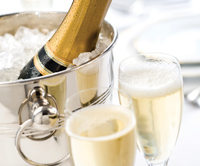 Traditional cabinet-making isn’t easy. You have to sculpt dovetail joints, dowels and teasal tenons. It’s a painstaking process that is best confined to those with lots of free time — my retired father, for example, or prison inmates. The rest of us can avoid such trouble by employing an exciting piece of technology: the screwdriver.
Traditional cabinet-making isn’t easy. You have to sculpt dovetail joints, dowels and teasal tenons. It’s a painstaking process that is best confined to those with lots of free time — my retired father, for example, or prison inmates. The rest of us can avoid such trouble by employing an exciting piece of technology: the screwdriver.
In this sense, making a footstool and making a bottle of sparkling wine are similar. There is a simple, modern way and a ridiculously elaborate traditional method. The modern way involves taking freshly fermented wine and fermenting it again in large vats. The second round of yeast imbues bubbles into the wine before bottling. The advantage of this process isn’t just ease; it also preserves the fresh, floral quality of the grapes. Italian Prosecco is made this way, which is why it’s inexpensive yet lovely.
The traditional method (or méthode classique) also uses yeast to create the carbonation, but this fermentation happens in the bottle. The bottled wine is aged for long periods with yeasty deposits inside, which eventually leaves the winemaker with a problem: how do you remove the dead yeast? After all, no one would drink Moët if it looked like yogurt. The solution is intricate and labour intensive: the floating yeast is coaxed into the neck of the bottle, where it forms a lump. The neck is then flash-frozen and the bottle opened so the yeast can slide out like a popsicle.
To be rich and complex, a sparkler must be made in the traditional method — look for such a designation on the label. Many countries, including Canada, use this method, but Champagne made it famous. Champagne’s characteristic hints of fresh bread and mushrooms come from the leached flavours of the decomposed yeast; unappetizing sounding, perhaps, but delicious. Equally vital is texture; a wine made in the traditional manner has smaller, softer and more persistent bubbles. After all, each one is crafted by hand.
Into the Short Cellar
![]() Moët & Chandon 2003 Grand Brut Rosé Champagne
Moët & Chandon 2003 Grand Brut Rosé Champagne
$87.95, France, Vintages #069831
Most Champagnes are composed of grapes from different years, but sometimes an excellent harvest will be bottled separately as a Vintage Champagne. Such elite bottles are designed to improve with age. This magnificently expressive dry Rosé is a great choice for drinking now until 2015. 94/100
![]() 13th Street Premier Cuvée Brut Sparkling Wine
13th Street Premier Cuvée Brut Sparkling Wine
$29.95, Niagara Peninsula, Vintages #142679
Some Ontario wineries have lately discovered their true calling by producing fantastic sparkling wine in the méthode classique: Hinterland, Jackson- Triggs and Flat Rock to name a few. But 13th Street has been at it a long time and remains one of the best. This Brut is gorgeous with notes of tropical fruit and fresh bread. 91/100
Champagne pairings
Don’t typecast sparkling wine. Usually served on its own or with hors d’oeuvres, it’s a supreme choice for many meals

Sushi: Champagne is rich enough to stand up to soya sauce, but also has an effervescent bite that enhances the flavours of the fish. Delicious.
 Fish and chips: A dry sparkler will cut through all the fat and batter, creating a complex and refreshing mouth sensation. However, it’s best to lay off the overpowering vinegar.
Fish and chips: A dry sparkler will cut through all the fat and batter, creating a complex and refreshing mouth sensation. However, it’s best to lay off the overpowering vinegar.
 Popcorn: You don’t need a special occasion to open the bubbly. The richness of expensive vintage Champagne is a perfect complement to the homiest pleasure: hot buttered popcorn.
Popcorn: You don’t need a special occasion to open the bubbly. The richness of expensive vintage Champagne is a perfect complement to the homiest pleasure: hot buttered popcorn.
Photo by Mark Swallow / istockphoto.com
Matthew Sullivan is a civil litigator in Toronto. He blogs weekly here on lawandstyle.ca. The Short Cellar column also appears in the print edition of Precedent. Matthew can be reached at matthew@lawandstyle.beta-site.ca. Follow along on Twitter: @shortcellar.

